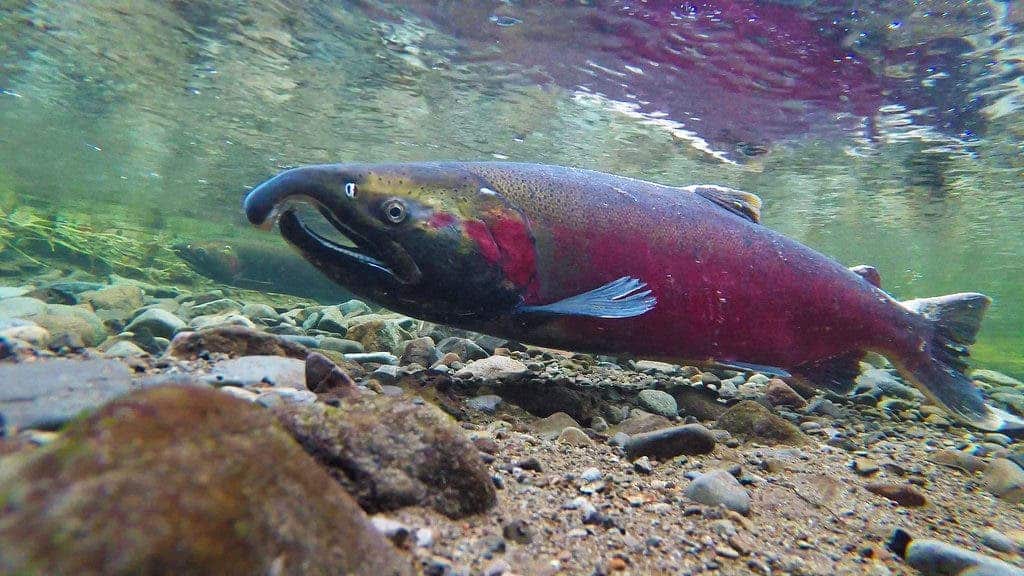Greenland and the Faroe Islands will completely stop commercial wild salmon fishing for the next 12 years. The move aims to allow the species to regenerate and return to rivers in Canada, the United States, and Europe.

Image credits Bureau of Land Management Oregon and Washington / Flickr.
It seems that one of the worst qualities an organism can have in the twenty-first century is being tasty. Case in point: wild salmon. While there are several wild species belonging to the family Salmonidae, nine of them are commercially-important — and they aren’t faring very well at all. Overfishing has left wild populations on the brink of collapse, with potentially disastrous consequences both on an environmental as well as economic and social level.
Teach a man not to fish
In an effort to allow Atlantic populations some time to recover, the Atlantic Salmon Federation and North Atlantic Salmon Fund have convinced Greenland and the Faroe Islands to stop commercial salmon fishing for the next 12 years. These two countries were selected as their coastal waters hold feeding grounds that are crucial for wild salmon, harboring many individuals from endangered populations in rivers like Saint John in New Brunswick and the Penobscot in Maine.
In exchange, the two organizations have pledged financial support for alternative economic development in Greenland, scientific research, and education projects focused on marine conservation.
For now, the exact details of this financial agreement are being kept confidential — but the Atlantic Salmon Federation is adamant that not government money will be involved. All funding will be raised by the two organizations or will come from private donations.
Greenland fishermen will also be allowed catches up to 20 metric tonnes per year for personal and family consumption only. Even so, the deal is estimated to allow over 11,000 mature salmon to return to home rivers in 2019 instead of ending up in a net.
And nothing sums up why we need to do this better than this somewhat obvious but very valid observation of Chad Pike, chairman of the North Atlantic Salmon Fund:
“The best way to save North Atlantic salmon is to stop killing them,” he told The Globe and Mail. “This deal does that in meaningful numbers.”
“Significantly reducing the harvest of wild Atlantic salmon on their ocean feeding grounds is meaningful and decisive,” adds Bill Taylor, president of the Atlantic Salmon Federation.
Wild salmon stocks have steadily dropped to alarming levels in the past few years, caught between overfishing, ecosystem shifts caused by climate change, and other run-of-the-mill human meddling. Stocks have dwindled from roughly 1.8 million individuals returning on salmon runs in North America in the 1970s and ’80s to under 418,000 individuals in 1990, and the sustained efforts of the Atlantic Salmon Federation (about which you can read more here) have managed to prop up their numbers to roughly 600,000 in recent years.
Still, the situation is far, far from improving. Salmon runs across the US are at an all-time low: in California, Oregon, Idaho, Washington, and southern British Columbia, many bring less than 10% of their historical numbers. Others have simply stopped happening altogether, according to this paper by Robert T. Lackey from the Department of Fisheries and Wildlife. This paragraph puts how dire the state of wild Atlantic salmon is today into chilling perspective:
“Every few years, there is a media celebration of ‘record’ salmon runs, but these temporary blips are due mainly to favorable ocean conditions coupled with a recalibration of what constitutes a ‘record’ run. If doubling a run from 2% to 4% of the historical level qualifies as a record run, then we are often there, however modest the increase may be,” he writes.
“More sobering, the majority of such runs are usually hatchery-bred fish. Nowadays wild salmon comprise less than a quarter of many West Coast salmon runs.”
Delegations from Greenland and the Faroe Islands will declare the zero commercial quotas at next month’s international summit in Portland, Maine, which will work retroactively to April 30.
The 12-year moratorium should cover two whole generations of wild Atlantic salmon, allowing them to reproduce in peace. Both organizations, as well as officials from the two countries, expect that this will help significantly raise population numbers in the long term.


